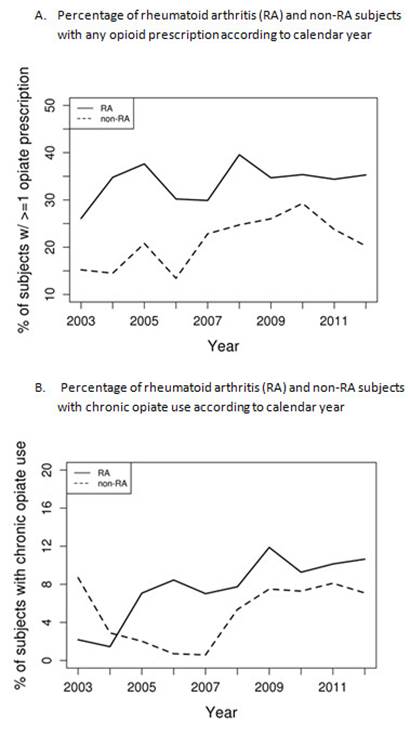Session Information
Session Type: ACR Poster Session A
Session Time: 9:00AM-11:00AM
Background/Purpose: Opiates
are often used to treat difficult to manage pain, however, little is known
about the trends of use for opiates in a modern cohort of patients with rheumatoid
arthritis (RA). We aimed to evaluate the use of opiates in patients with RA
compared to non-RA subjects.
Methods: Retrospective
prescription data was examined from 2003-2012 in well-defined population-based
incidence cohort of patients with RA by 1987 ACR criteria in 2003-2007 and age/sex
matched to non-RA subjects. Any opiate use was defined as one or more
prescriptions in the study period and chronic use was defined as 60 days or
more of prescribed opiates (at usual dose and usual schedule) in a 6 month
period; or those subjects using fentanyl, methadone and controlled/sustained
release oxycodone. Disease severity indicators used were RF/ACPA positivity, rheumatoid
nodules and erosions in the first year, male sex, and ESR values. Poisson
models and age and sex adjusted Cox models were used to examine differences in
opiate use between the cohorts.
Results: A total of 404
subjects (202 pairs; 69%female) were included in the study with a mean age of
55 ± 15.7 and a mean follow-up date of 6.5 ± 2.4 years. The most frequently
prescribed opiate in our study was oxycodone (40%) followed by hydrocodone
(20%).
Opiate use (any) was high in both
cohorts (35% RA vs 20% non-RA in 2012). Patients with RA had a 54% higher rate
of opiate use compared to non-RA subjects (rate ratio {RR}: 1.54; 95%
confidence interval {CI}: 1.36, 1.74; Fig. 1a). Chronic opiate use was also
common in both cohorts (11% RA vs 7% non-RA in 2012). Patients with RA had a
70% higher rate of chronic opiate use (RR: 1.70; 95% CI: 1.15, 2.53) compared
to non-RA subjects (Fig. 1b).
The rate of chronic opiate use
increased in both cohorts by 11% per year with no apparent difference in time
trends between the cohorts (interaction p=0.46). Women in both cohorts were
more likely to be chronic opiate users than men (Hazard ratio [HR]: 1.82; 95%
CI: 1.01-3.29). Compared to non-RA subjects, chronic opiate use was higher in
younger patients with RA (age 18-49; 3.4% RA vs. 0.5% non-RA), we saw no
difference in those over 65 years of age (interaction p=0.007), and a numerically
intermediate risk in those 50 to 64. The only marker of disease severity and
chronic opiate use was presence of rheumatoid nodules (HR: 1.95; 95% CI:
1.00-3.81).
Conclusion: Opiate use is
common. Throughout the study period, rates of any opiate use remained stable
but were always significantly higher in patients with RA than those without RA.
However, rates of chronic opiate use increased in both cohorts over time and
were consistently higher in patients with RA, especially among younger patients
and women. In RA, opiate use was generally not related to disease severity
indicators suggesting an alternate pain generating pathway.
To cite this abstract in AMA style:
Zamora-Legoff JA, Achenbach SJ, Crowson CS, Davis JM III, Matteson EL. Trends in the Use of Opiates in Rheumatoid Arthritis (RA) Compared to Non-RA: A Population Based Study in 2003-2012 [abstract]. Arthritis Rheumatol. 2015; 67 (suppl 10). https://acrabstracts.org/abstract/trends-in-the-use-of-opiates-in-rheumatoid-arthritis-ra-compared-to-non-ra-a-population-based-study-in-2003-2012/. Accessed .« Back to 2015 ACR/ARHP Annual Meeting
ACR Meeting Abstracts - https://acrabstracts.org/abstract/trends-in-the-use-of-opiates-in-rheumatoid-arthritis-ra-compared-to-non-ra-a-population-based-study-in-2003-2012/

